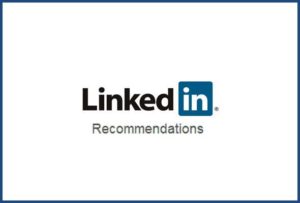
One of the best ways to get a recommendation on LinkedIn is to offer to write one in return. You have probably worked with others over the years who you would be happy to recommend, and the LinkedIn Recommendations feature provides a perfect forum to endorse others. The challenge for most of us, according to writer Adrian Granzella Larssen (Your 5-Minute Guide to Writing an Amazing LinkedIn Recommendation), is finding the right words that will honestly express your feelings about the person in a clear and concise way.
Employment strategist Adrienne Tom suggests that your recommendation be genuine, specific, descriptive, impactful (including examples of achievements if possible) and honest (see Write a LinkedIn Recommendation that Resonates). Ms. Tom also advises that you understand the person’s goal in requesting your recommendation to help you tailor it to meet their needs, such as wanting a new job, seeking a promotion or making a career change.
The following are some ideas to guide you through the process of writing a LinkedIn recommendation:
Open with a strong statement. As with any good writing, you want to start with a line that grabs your audience and makes them want to read more. Human capital specialist Michael Schneider (How to Write the Perfect LinkedIn Recommendation in 1 Paragraph) calls the opening sentence the “hook.” He emphasizes that a great hook is concise, clearly states your primary message and sets the tone for the rest of the recommendation. An example of an effective hook is “Jane is a natural leader with an uncanny ability to motivate and develop others.”
Describe your professional relationship. Give readers some context as to how you know the person, including your reporting relationship, what you worked on together and the length of time you’ve known each other. It’s important to let readers know why you’re qualified to give the recommendation. Examples include “I’ve worked alongside Lisa for close to two years now” or “I had the pleasure of working with Jim for two years at the Smith Company, collaborating on several project teams.”
Highlight what makes the person exceptional. Focus your recommendation on one or two things this person does better than anything else or that really stand out to you above others. You can also include any information that demonstrates the impact the person had on you or your organization. For example, “Matt’s ability to juggle multiple projects was unlike any I’ve seen before and made a dramatic difference in the productivity level of our team.”
Add a personal note. If possible, share something about what it’s like to work with this person or some insight into his or her personality. For example, you could add a sentence that shows the person not only gets the job done, but also is great to work with. “No matter how tense a meeting, Annie made sure everyone left with a smile.”
End with a clear recommendation. Close your recommendation with a strong finish that makes it clear you give your contact an enthusiastic thumbs-up. Examples of a short and solid recommendation are “Allison would be an asset to any team” or “Any employee would be lucky to have Michelle as a manager.”
Keep your recommendations under 200 words whenever possible. Lengthier recommendations are less likely to hold a reader’s interest, and key information can become buried. A few well-thought-out sentences can pack a lot of punch with only 50 to 100 words. Think quality of content versus quantity.
The most effective LinkedIn recommendations, says marketing content writer Corey Wainwright (How to Write a LinkedIn Recommendation in 2019), are specific, honest, succinct and, above all, helpful for the person you’re recommending.
